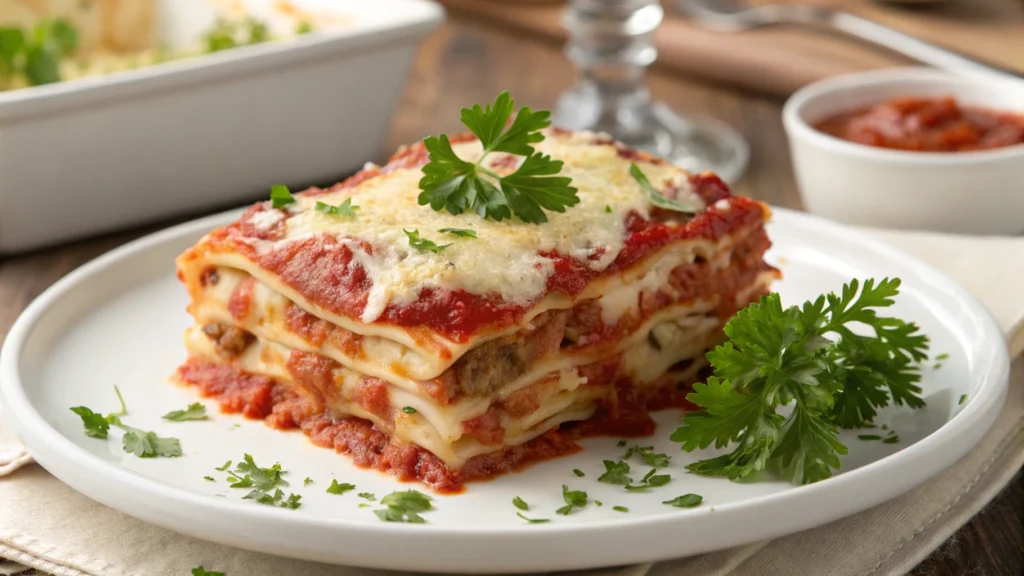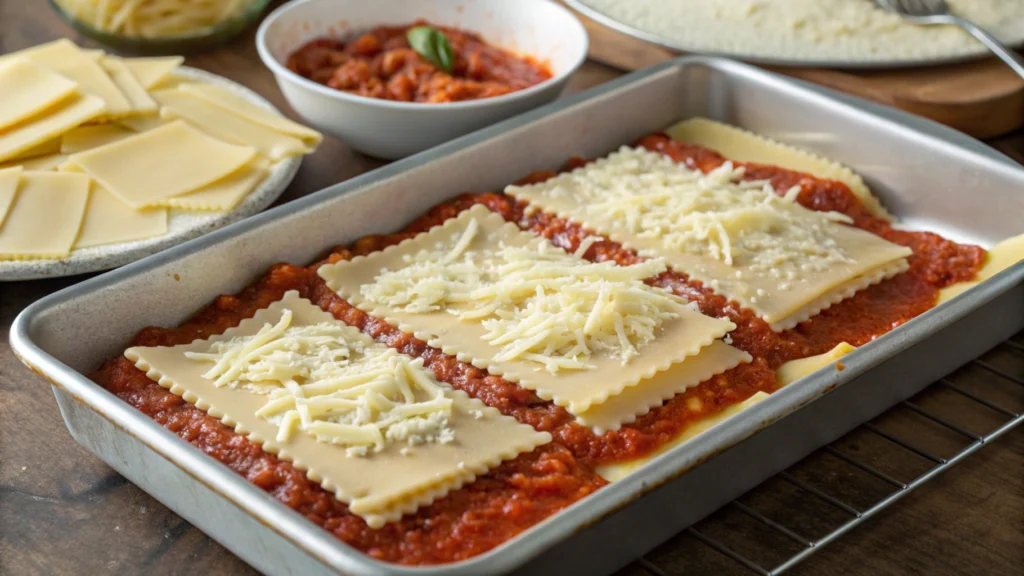Introduction

Cooks worldwide love lasagna for its classic Italian flavors. This iconic dish layers pasta, hearty sauces, and rich cheese to create a masterpiece. Cheese plays a big role in enhancing the flavor and texture of the dish.
Many home chefs debate whether to use cottage cheese or ricotta in their recipes. Some prefer the mild and chunky texture of cottage cheese. Others enjoy the creamy and slightly sweet taste of ricotta. Each cheese offers unique qualities that can transform your lasagna in different ways.
This article compares cottage cheese and ricotta, focusing on their textures, flavors, and nutritional profiles. You’ll discover which cheese works best for your lasagna and learn whether combining both could deliver the perfect result.
The Role of Cheese in Lasagna
Why Cheese Matters in Lasagna
Cheese does more than just add flavor to lasagna—it’s the glue that binds the dish together. Its creamy consistency balances the acidity of the tomato sauce and the richness of the meat. Furthermore, cheese enhances the texture, creating a satisfying contrast with the pasta layers. A good cheese can truly transform an ordinary lasagna into a culinary masterpiece.
When layered correctly, cheese creates pockets of gooey, melty goodness in every bite. It also helps hold the structure of the dish, ensuring that your lasagna stays intact when you cut and serve it. Whether you prefer a mild or bold flavor, choosing the right cheese is critical to achieving the perfect lasagna experience.
How Cheese Interacts with Other Ingredients
Cheese interacts beautifully with other lasagna components. For example:
- Tomato Sauce: Cheese softens the tangy, acidic flavor of tomatoes, making the dish feel more balanced.
- Meat: The richness of cheese complements the savory taste of beef, sausage, or chicken in the filling.
- Pasta: Cheese adds moisture and creaminess, which prevents the lasagna from feeling dry or overly dense.
The type of cheese you choose directly affects these interactions. For instance, some cheeses, like ricotta, add creaminess, while others, such as cottage cheese, create a chunkier texture. Therefore, understanding these dynamics can help you decide which cheese suits your lasagna style best.
Comparing Cheese Choices: Cottage vs Ricotta
Cottage Cheese in Lasagna

What is cottage cheese?
Cottage cheese is a fresh cheese with a mild flavor and a slightly tangy edge. It has small curds that add texture, making it a popular choice for low-fat and high-protein diets. Unlike aged cheeses, cottage cheese offers a lighter and fresher taste, which some people enjoy.
Advantages of Using Cottage Cheese
- Low in Fat: Cottage cheese often contains less fat than ricotta, making it ideal for healthier lasagna recipes.
- High in Protein: With its protein content, it provides a filling and nutritious option.
- Budget-Friendly: Cottage cheese is typically more affordable than ricotta, which can make a difference for large meals.
- Easier Availability: You can find cottage cheese in almost any grocery store, often in a variety of fat levels.
Disadvantages of Using Cottage Cheese
Milder Flavor: Some people find its taste less rich and creamy compared to ricotta.
Chunky Texture: Cottage cheese doesn’t have the smooth consistency that some lasagna lovers expect.
Watery Composition: Its high moisture content can make the lasagna runny if not properly drained.
Ricotta Cheese in Lasagna
What is ricotta cheese?
Ricotta cheese, a staple in Italian cooking, is a creamy, soft cheese with a mild, slightly sweet flavor. Made from whey leftover during the production of other cheeses, it has a fine, grainy texture that melts beautifully in baked dishes like lasagna. Because of its rich and smooth consistency, ricotta creates a luxurious layer in your dish.
In fact, chefs often use ricotta as a key ingredient in traditional Italian recipes. Its ability to blend seamlessly with herbs, seasonings, and other cheeses makes it a versatile choice for lasagna.
Advantages of Using Ricotta Cheese
Ricotta cheese offers several benefits that make it a favorite for lasagna recipes:
- Creamy Texture: Ricotta’s smooth and creamy texture allows it to spread easily between pasta layers. Additionally, it provides a rich and satisfying mouthfeel.
- Authentic Flavor: For those seeking a traditional Italian lasagna, ricotta delivers the classic taste that many associate with the dish.
- Versatility: Ricotta pairs well with a variety of ingredients, including spinach, herbs, and other cheeses. As a result, it’s perfect for both vegetarian and meat-based lasagnas.
- Low Moisture Content: Unlike cottage cheese, ricotta has less water, which reduces the risk of a watery lasagna.
Disadvantages of Using Ricotta Cheese
While ricotta is a popular choice, it does come with a few drawbacks:
- Higher Fat Content: Ricotta tends to have more fat than cottage cheese. For those watching their calorie intake, this could be a concern.
- Costlier Option: Ricotta is often more expensive than cottage cheese. Therefore, it might not fit every budget.
- Potentially Heavy: The richness of ricotta can make lasagna feel dense or overly heavy if you don’t balance it with lighter ingredients.
Nutritional Comparison: Cottage vs. Ricotta
When deciding between cottage and ricotta cheese, nutritional content is an important factor. Here’s a side-by-side comparison:
| Nutrient | Cottage Cheese (1/2 cup) | Ricotta Cheese (1/2 cup) |
|---|---|---|
| Calories | ~100 | ~180 |
| Protein | ~7 g | ~12 g |
| Total Fat | ~2g (low-fat option) | ~12g |
| ~3 g | ~3g | ~400 mg |
| ~6 g | ~80 mg | ~80mg |
Key Takeaways:
If you need to manage sodium intake, ricotta has a significant advantage due to its lower sodium levels.
Cottage cheese is higher in protein and lower in fat, making it a better option for those prioritizing a lean diet.
Ricotta contains more fat but offers a creamier texture and richer taste.
Taste and Texture Comparison
How Cottage and Ricotta Cheese Differ in Taste
The choice between cottage cheese and ricotta often comes down to taste preference. Cottage cheese has a mild, slightly tangy flavor. Its taste doesn’t overpower other ingredients, which makes it a great option for recipes that rely on a balanced flavor profile. On the other hand, ricotta boasts a creamy, slightly sweet flavor. This richness enhances the dish’s overall taste, especially in traditional lasagna recipes.
For those who enjoy subtle flavors, cottage cheese provides a neutral base. However, if you want to highlight the cheesy element in your lasagna, ricotta might be the better choice. Additionally, ricotta pairs exceptionally well with herbs like basil and parsley, elevating the dish’s complexity.
Textural Differences Between Cottage and Ricotta Cheese
Texture is another key factor when deciding between the two cheeses. Cottage cheese has small curds, giving it a slightly chunky texture. While some people appreciate this bite, others find it less appealing in lasagna. To improve its texture, many cooks blend cottage cheese before adding it to recipes.
Ricotta, by contrast, has a smooth and creamy consistency. This texture allows it to spread easily across lasagna layers. It also creates a unified, cohesive dish when baked. For individuals who prioritize a luxurious, velvety finish in their lasagna, ricotta is often the preferred choice.
Popular Preferences Around the World
Cheese preferences in lasagna vary based on regional and cultural influences. Ricotta is the preferred cheese in traditional Italian lasagna. Italians typically use it alongside mozzarella and Parmesan to create rich, indulgent layers.
In the United States, however, many home cooks opt for cottage cheese. Its affordability and availability make it a common alternative to ricotta. Additionally, cottage cheese aligns well with modern preferences for lighter, higher-protein meals.
Meanwhile, other regions experiment with unique variations. For example:
- In Northern Italy, chefs may use béchamel sauce instead of ricotta, focusing on creaminess from the sauce rather than the cheese.
- In Eastern Europe, cooks sometimes incorporate farmer’s cheese, which has a texture similar to ricotta but a tangier flavor.
- In the Mediterranean: Some recipes include feta cheese for a salty, briny twist.
Global Cheese Trends in Modern Lasagna Recipes
Today, chefs and home cooks alike are blending tradition with creativity. Many recipes now incorporate both cottage cheese and ricotta to combine the benefits of both ingredients. This trend allows for a balance of texture, flavor, and nutritional benefits. For instance, mixing cottage cheese with a small amount of ricotta creates a lighter dish without compromising on creaminess.
Practical Tips and Techniques for Choosing and Using Cheese in Lasagna
How to Choose the Right Cheese for Your Lasagna
Selecting the right cheese for your lasagna depends on your preferences, dietary needs, and the type of lasagna you plan to make. Here are a few practical tips to help you decide:

- Consider the Texture You Want:
- Choose ricotta if you prefer a smooth, creamy texture that blends seamlessly into the dish.
- Opt for cottage cheese if you like a chunkier, heartier bite or want a lighter option.
- Balance the Nutritional Profile:
- For a lower-fat, high-protein alternative, cottage cheese is the better choice.
- If you’re looking for indulgence and richness, ricotta delivers the traditional experience.
- Think About the Recipe Style:
- Traditional Italian lasagnas usually use ricotta for an authentic taste.
- Modern variations or healthier recipes often incorporate cottage cheese.
- Blend for the Best of Both Worlds:
- Mix equal parts of cottage cheese and ricotta to combine texture and flavor. This approach gives you creaminess without adding too much fat.
Cooking Techniques for Cottage and Ricotta Cheese
Using Cottage Cheese in Lasagna
Cottage cheese requires a few extra steps to ensure the best results in your lasagna:
- Drain Excess Moisture: Place the cottage cheese in a fine-mesh strainer or cheesecloth. Let it sit for 10–15 minutes to remove any liquid that could make the lasagna watery.
- Blend for Smoothness: If you want a creamier texture, blend the cottage cheese in a food processor before using it. This step helps mimic ricotta’s smooth consistency.
- Season Well: Cottage cheese has a mild flavor, so add salt, pepper, and herbs like parsley or oregano to enhance its taste.
Using Ricotta Cheese in Lasagna
Ricotta is naturally creamy and requires less preparation, but here are some tips to make it shine:
- Season to Taste: Ricotta’s flavor can be enhanced by adding a pinch of salt, pepper, and nutmeg.
- Add an Egg: Mix one beaten egg into the ricotta before layering. This step helps the cheese bind better and prevents it from becoming too runny during baking.
- Combine with Mozzarella or Parmesan: Ricotta works beautifully when paired with these cheeses, creating a rich and cohesive flavor profile.
Creative Cheese Substitutions for Lasagna
If you don’t have cottage cheese or ricotta on hand, don’t worry—there are plenty of substitutes that work well in lasagna:
- Mascarpone Cheese: This rich and creamy option is an excellent replacement for ricotta in indulgent recipes.
- Greek Yogurt: For a healthier twist, use plain Greek yogurt. It offers tanginess and creaminess while being lower in fat.
- Cream Cheese: Blend cream cheese with a bit of milk for a ricotta-like consistency.
- Farmer’s Cheese: This tangy cheese is similar to cottage cheese but has a finer texture, making it a great alternative.
Enhancing Flavor with Cheese Blends
Experimenting with cheese combinations can elevate your lasagna to the next level. For example:
- Three-Cheese Blend: Combine ricotta, mozzarella, and Parmesan for a rich, cheesy lasagna.
- Cottage Cheese and Cheddar: Use this mix for a sharper flavor in a modern twist on the classic recipe.
- Ricotta and Goat Cheese: This pairing adds a tangy, sophisticated touch to your dish.
Final Tips for Perfect Lasagna Layers
- Spread cheese layers evenly to ensure consistent flavor in every bite.
- Use quality cheeses to maximize taste and texture.
- Bake lasagna covered for the first half, then uncover to let the cheese brown beautifully on top.
Conclusion
Lasagna lovers often face a crucial question: cottage cheese or ricotta? Each cheese offers unique benefits, and your choice ultimately depends on your taste preferences, nutritional goals, and recipe style. Cottage cheese provides a lighter, high-protein option with a chunkier texture, while ricotta delivers a creamy, traditional taste that feels indulgent.
The good news is that you don’t have to choose just one! Combining both cheeses allows you to experience the benefits of both lightness from cottage cheese and richness from ricotta. Either cheese can enhance your dish, whether you’re crafting a traditional Italian lasagna or incorporating a contemporary twist.
By understanding their differences and applying the tips shared in this article, you’re well-equipped to create a delicious lasagna that suits your needs. So, grab your ingredients, layer up, and enjoy a cheesy, satisfying meal!
